01 of 26

On the night of September 6, 1776 the Turtle, piloted by Ezra Lee, set out into New York Harbor to sink the
British flagship Eagle with Admiral Howe on board. Although unsuccessful, the attempt inspired inventors throughout
the 19th century industrial revolution to develop this potentially devastating mode of naval warfare.
As eye witnesses to historical events pass on, modern descriptions must be based on interpretation. In their book
TURTLE: David Bushnell's Revolutionary Vessel, authors Roy Manstan and Fred Frese provide their interpretation
of this unique concept of submarine warfare that was more than 100 years ahead of its time.
|
02 of 26
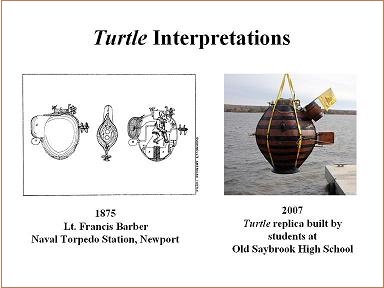
The most widely used interpretation was provided by Lieutenant Francis Barber whose illustration of the Turtle
has appeared in every book and article written on the subject. Barber was an instructor at the Naval Torpedo Station in
Newport, Rhode Island in 1875 where he described Bushnell's submarine to his students in his "Lecture on Submarine Boats
and their Application to Torpedo Operations."
In 2003 a group of students at Old Saybrook [Connecticut] High School were given the opportunity to build an updated
interpretation of the Turtle. Under the direction of authors Manstan and Frese, these 21st century
students designed and built all of the elements that enabled David Bushnell to create his 18th century wooden
submarine. In November 2007, this modern interpretation was launched into the Connecticut River within sight of where
Bushnell first tested the original Turtle in 1775.
|
03 of 26
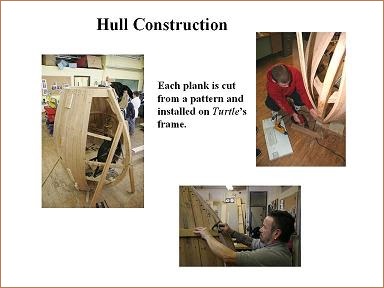
Although there are no records of how the original Turtle was constructed, the wooden hull of the replica was
created using barrel staves, each cut and fitted by the students. The High School's technical arts teacher Fred Frese
(bottom photo) guided them through each phase of construction.
|
04 of 26

The submarine hatch was the most complex component that challenged both David Bushnell and the High School students.
Author Manstan, at the time an engineer at the Naval Undersea Warfare Center [NUWC, the current descendant of Lt Barber's
Torpedo Station] established an education partnership agreement with Old Saybrook High School. Under this agreement a
full-scale model (upper left) of a modern hatch, designed around Bushnell's concept, was produced for use as a casting
pattern.
The Mystic River Foundry [Mystic, CT] donated the brass casting that was then brought to the NUWC machine shop (shown
with the students) where the finishing touches were completed. One of the students then fitted the hatch to the
Turtle's steel deck. The final installation is shown during the November, 2007 launch in the Connecticut River.
|
05 of 26
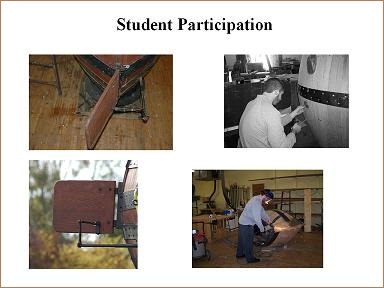
Although all of the students worked as a team, each was assigned a particular component of their submarine. One
student designed and built the rudder, another student worked with the water pumps and valves (shown here installing a
screen over the bilge pump outlet), while another cut and fit the steel deck.
|
06 of 26
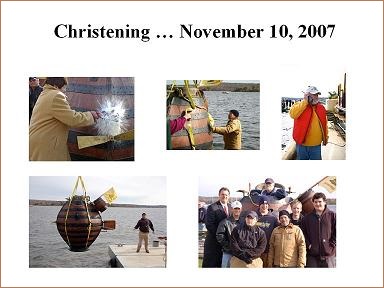
After four years, the Old Saybrook High School replica of David Bushnell's Turtle was christened by State
Senator Eileen Daily and launched into the Connecticut River. The pilot was Roy Manstan who had recently retired from the
Naval Undersea Warfare Center where he had been a mechanical engineer and Navy trained diver. Multiple safety features and
emergency procedures had been included, and Manstan's Navy dive team (directed by fellow diver and FOSA member Ken
Beatrice (upper right) was on hand during the launch. Many of Frese's students who had graduated the previous June watched the
launch, a few of them shown with the Turtle (lower right).
|
07 of 26
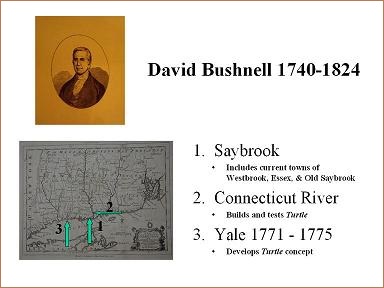
David Bushnell was raised in the town of Saybrook at the mouth of the Connecticut River. This large community
eventually split into three districts that eventually became the present day towns of Essex, Westbrook, and Old Saybrook.
When Bushnell's father died, the family farm in the Pachaug district (now Westbrook) was passed to David and his
brother Ezra. David eventually sold his interest in the farm to Ezra and in 1771 used the money to attend Yale College.
|
08 of 26

Education was a major concern among the colonies, and by the early 18th century laws had been passed
creating the public financed school system we know today.
Although the colonial economy was primarily based on agriculture, the several colleges that had been established in
the colonies were beginning to provide their students with classes in the science and technology that had evolved during
the 17th century "Age of Enlightenment."
|
09 of 26
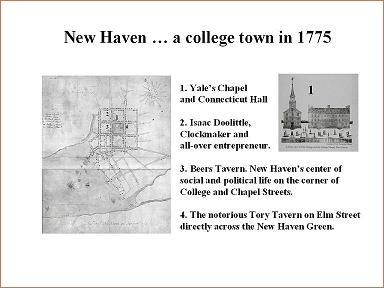
New Haven was founded in the early 17th century and soon became a busy port city along the Connecticut
coast. Yale College originated in Saybrook in 1701, but had moved to New Haven in 1716. Although many graduates had been
destined to become ministers in the Congregational Church, the rising interest in science, then known as "natural
philosophy," began providing students with careers other than the ministry.
It was the deteriorating relationship between England and the American colonies that inspired David Bushnell to apply
his interest in science to developing a new mode of naval warfare embodied in his "submarine vessel" eventually to become
known as the Turtle.
The challenge that Bushnell faced was to convince his peers and supporters that his concept of submarine warfare was
not only scientifically legitimate but operationally feasible. Much of his convincing may have occurred across the street
from the college at Beers Tavern.
|
10 of 26
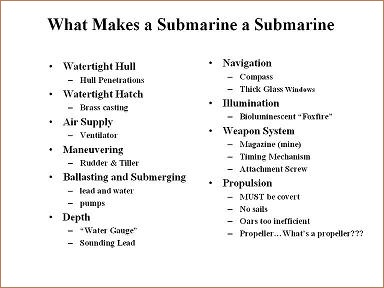
The task of designing, building, and operating his submarine vessel required a deep understanding of the science behind
each element that had to be created in order to produce an effective weapon that would not turn into a suicide mission.
But most important to the development of any technology is obtaining resources that might be better assigned to other
priorities. First, Bushnell's vessel required that he obtain nearly a thousand pounds of lead as ballast. Second, the
weapon that he proposed included an explosive charge housed in a wooden container detonated by a clockwork timing
mechanism. Each underwater mine, designed to be attached to the underside of a warship, contained 150 pounds of
gunpowder...and it is felt that Bushnell had produced at least three of these. At the onset of the Revolutionary War, both
of these commodities were in short supply. A standard musket ball weighed an ounce, thus 16,000 of these could be produced
with the lead Bushnell was asking for - and these 16,000 musket balls could all be fired at the British with the gunpowder
he needed.
|
11 of 26
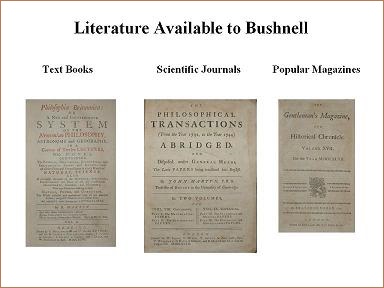
Present day scientists and engineers rely on their peers and predecessors when developing the modern technologies we
enjoy today. The same was true in David Bushnell's time when science had evolved during the previous century. The
accomplishments and the ideas they had generated were published in journals and text books that Bushnell had read while at
Yale. This same information also found a home in the popular literature that had been published in the many monthly
magazines available during the 18th century.
Bushnell's submarine vessel incorporated many ideas that had their origins in these books. Bushnell's engineering
genius was his ability to apply these scientific concepts to the solution of each complex design problem he faced. Bushnell
also depended on the creative talents of many individuals, both among the scientists and professors who mentored his ideas,
and the local artisans that had the ability to convert these ideas into a real piece of hardware.
|
12 of 26
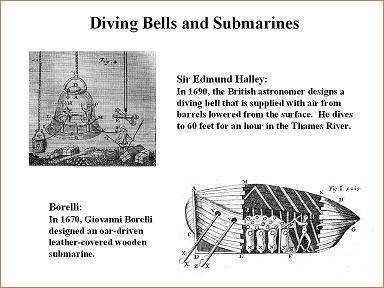
Seventeenth century scientists had experimented with ideas designed to enable humans to explore the oceans. Sir Edmund
Halley, the namesake of Halley's Comet, was as interested in the study of the heavens as he was in what existed beneath
the sea. Although space travel had been postulated in the 17th century, Halley's scientific curiosity could
only be satisfied by designing a diving bell that took him into the depths. Other creative individuals had built vessels
capable of descending beneath the sea, but they were crude adaptations of surface vessels propelled by oars.
Bushnell understood that the physics associated with underwater exploration was applicable to creating a naval vessel
that would also take a human into underwater combat. His challenge was providing efficient propulsion, and the stealth
associated with a night attack. The stakes were much higher for a military mission than a scientific or salvage operation.
|
13 of 26
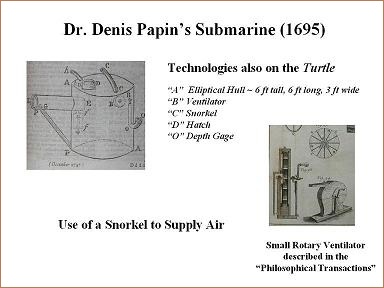
One submarine concept that most likely influenced Bushnell as his design evolved was proposed by mathematician Denis
Papin in 1695. There is no evidence that Papin's submarine was ever produced, but the idea was described in the
Gentleman's Magazine in 1747. Both Papin and Bushnell had to account for the vessel's mobility, structural strength,
buoyancy, air supply, and depth control.
The use of a snorkel was included by both inventors, where a source of air could be provided to the pilot from a
"rotary ventilator" while transiting on the surface. The concept of a centrifugal pump had been described in the journal
"Philosophical Transactions" and would have been among the books at Yale when Bushnell was a student.
|
14 of 26
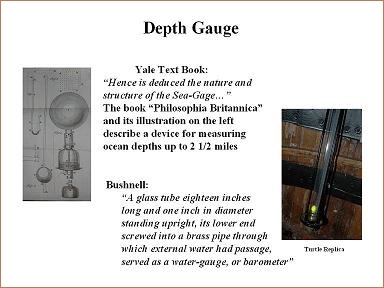
In order to attack an 18th century Man-of-War, the Turtle would have to maneuver at night under the
hull. Bushnell (and Papin) had devised a "water-gauge" that would indicate when the submarine had descended deep enough to
access the keel (about 20 feet) where the explosive charge would need to be attached. This depth gauge was an adaptation
of the relationship between depth and pressure developed by Robert Boyle in the 17th century.
Because the attack would occur at night, Bushnell added a bioluminescent material (the root structure of a mushroom)
called "foxfire" to illuminate both the markings in the depth gauge as well as the compass used to navigate at night.
|
15 of 26

Bushnell also had to solve some very practical problems including the installation of hand-operated bilge pumps on
either side of the pilot. Ballasting was adjusted by adding or removing water from the interior of the hull just below the
pilot (the bench seat for the pilot has been removed) visible in the photo of the replica interior showing the opening to
the bilge.
Propulsion was provided by a propeller turned by a combination of a hand-crank and a foot-operated treadle similar to
that used with a typical 18th century spinning wheel.
|
16 of 26
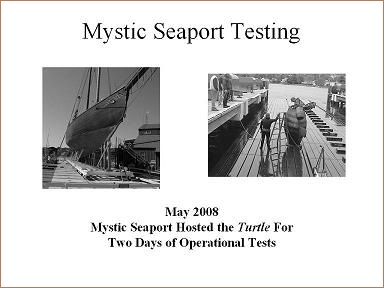
After our successful launch of the Turtle in November, 2007 we were invited to conduct a series of operational
tests at the Mystic Seaport Museum in Mystic, CT. The Seaport had recently installed a "shiplift" facility at the south
end of their waterfront. The shiplift is designed to bring their historic ships onto shore for maintenance and restoration.
There was a brief time in May, 2008 when the shiplift was available for our replica shown in the photo waiting for the
next test.
|
17 of 26
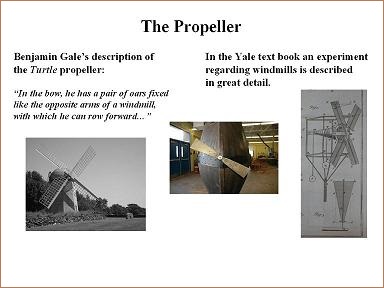
Of all Bushnell's adaptations of 18th century mechanical devices, the most ingenious was his use of a
bladed propeller. Previous "submarines" had employed oars that were inefficient and difficult for the operator to control.
The Turtle's propeller was described as "a pair of oars fixed like the opposite arms of a windmill." In 1776, there
was no word "propeller" and made it difficult for Bushnell and other eye witnesses to describe what was the first
adaptation of windmill technology (described in Bushnell's text book) as a means of propulsion.
By the turn of the century, Bushnell's ideas had been used by other inventors including Robert Fulton who included a
hand-cranked propeller on his Nautilus, a submarine concept he tried to sell to the French, British, and American
navies during the first decade of the 19th century. It would not be long before the steam engine was included
with the propeller for large ocean-going vessels.
A hand cranked propeller was also used with the Confederate submarine Hunley when it attacked the US warship
Housatonic in 1864. It wasn't until the end of the 19th century when batteries enabled electric motors
to be used for propeller driven submarines.
|
18 of 26

One of the tests included measuring the thrust produced by the propeller turned at various revolutions per minute
(rpm). Because there were no drawings of the original propeller, we had to depend on verbal descriptions by various eye
witnesses. Based on their descriptions and where we felt Bushnell had arrived at his propulsion concept, we devised several
potential designs. The photo shows a support diver installing one of the propellers.
The Old Saybrook High School students were involved with the testing and making the engineering measurements that are
included, for example, in the plots of Propeller Thrust vs. RPM.
|
19 of 26

These same propeller designs were used to measure the speed obtained when transiting. The original Turtle
remained on the surface during its night-time approach to the HMS Eagle in 1776, only submerging when in contact
with its target. Thus we were most interested in the speed that the Turtle was capable of while operating on the
surface. After several transits along the Mystic Seaport facilities, we determined that the pilot could sustain about
½ knot with moderate effort.
We also measured how much resistance the hull experiences when moving through the water at various speeds. We found
that a bow wave began to form at 1 knot; any speeds beyond that would significantly increase the amount of effort the
pilot would have to exert. From these tests, we estimate that 1 knot was the maximum speed that the original pilot Ezra
Lee could have maintained during the attack.
It's worth noting that FOSA members Ken and Bonnie Beatrice worked with the Old Saybrook students throughout the
replica testing at the Mystic Seaport, as well as taking soundings to determine launch locales, and doing the historical
research necessary to to build a truly representative replica.
|
20 of 26
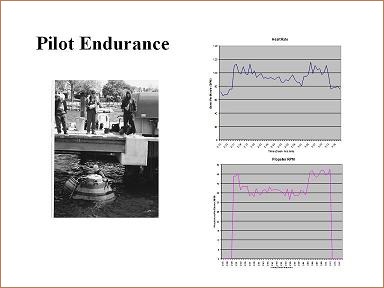
We selected a test pilot that was the same age as Ezra Lee for the replica test where we measured pilot endurance.
From the previous tests, we had selected what we felt was the most likely propeller design and had our test pilot turn the
propeller at various speeds over a 45 minute period. The pilot's heart rate was recorded and compared to the propeller RPM.
The plots show a direct relationship between these two measurements. We also recorded blood oxygen levels and they
remained well within safe limits. Based on these results and the pilot's comments we are confident that Ezra Lee could
also have sustained the operation of the Turtle during the hours that he maneuvered toward the Eagle.
|
21 of 26

Submerging was an important and complex procedure that the original Turtle pilot would need to master. We used
the most experienced test pilot to conduct the same submerging operation with the replica. The most critical time was
adjusting the internal buoyancy by adding water to the bilge until the vessel became neutrally buoyant. At this point, a
small propeller mounted near the top to the vessel was turned to force the vessel down into the water. The replica hovered
just below the surface long enough to prove that the submerging operation was possible. The test pilot then pumped out
enough of the ballast water to regain positive buoyancy and return to the surface.
|
22 of 26
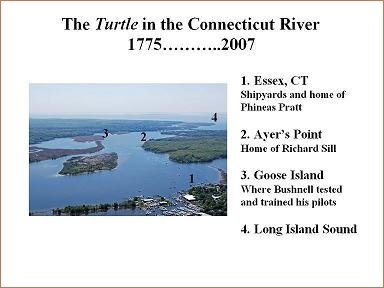
This aerial view of the mouth of the Connecticut River shows territory very familiar to David Bushnell.
1. In 1775, the town of Essex was the Potapaug district of Saybrook where Bushnell enlisted his most trusted mechanic
and one of the Turtle pilots, Phineas Pratt. This is also where the Turtle replica was launched on
November 10, 2007.
2. Bushnell lived at the home of Richard Sill at Ayer's Point while completing construction of his "submarine vessel"
in 1775.
3. Just across the river from the Sill house, near Goose Island, Bushnell found water deep enough to test the operation
of the Turtle and was where his pilots were trained.
4. During the summer of 1776, Bushnell and the Turtle left the safety of the Connecticut River on board a sloop
and headed into Long Island Sound. From there, he sailed to Manhattan and New York Harbor where the world's first encounter
between a warship and a submarine took place.
|
23 of 26
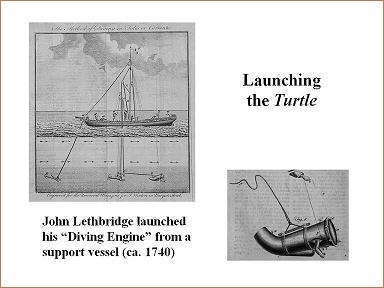
David Bushnell required a capable crew to handle the launch and retrieval of this tiny yet heavy submarine that
weighed nearly two tons. To the maritime American colonies, however, handling heavy items was routine. The illustration
shows a sloop and the standard 18th century load-handling rigging that British diver John Lethbridge used to
support his "diving engine."
|
24 of 26
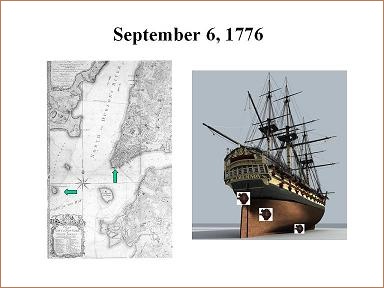
Shortly before midnight on September 6, 1776, Ezra Lee set out in the Turtle with a mission to sink the British
flagship HMS Eagle carrying Admiral Howe. After spending a half hour beneath Eagle, Lee was running out of
air and had to surface. Faced with early morning daylight, Lee decided to head back to New York where he and Bushnell
could wait for another opportunity. The British on Governor's Island, however, saw the vessel and as they approached, Lee
jettisoned the mine. Seeing this, the British withdrew and after a half hour, the clockwork triggered the detonation
providing everyone with a spectacular view of the explosion.
As there are no illustrations of Eagle, an identical Man-of-War, HMS Agamemnon, is used here to show
the approach and maneuvering of the Turtle beneath the hull. The authors of TURTLE: David Bushnell's
Revolutionary Vessel have proposed one theory as to why Lee was unable to attach his mine to the underside of the
Eagle. When Lee adjusted his ballast to become neutrally buoyant, he submerged into fresh water that flows into the
harbor from the Hudson River. As Lee descended, he encountered the deeper layer of salt water entering the harbor from the
Atlantic Ocean. He would have struggled to move down into this more buoyant salt water in order to maneuver under the
Eagle's keel, soon running out of breathable air and requiring him to return to the surface.
|
25 of 26
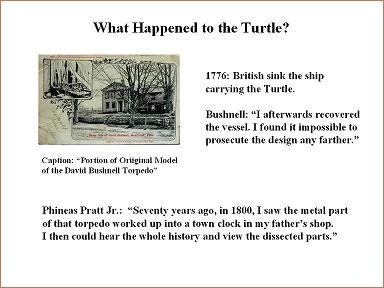
A week after Lee's unsuccessful attack, the British began their invasion of Manhattan. Bushnell and the Turtle
were carried up the Hudson River while George Washington and the Colonial Army abandoned New York City. Ezra Lee and
Phineas Pratt made two additional attempts against British warships, both also unsuccessful but now due to the excessive
river currents. The sloop carrying the Turtle was sunk near Dobb's Ferry. Bushnell was later able to recover his
vessel that was most likely brought back to the family farm in Saybrook where it was dismantled and the components used
for other purposes.
|
26 of 26
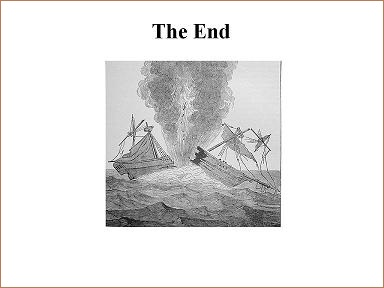
In 1805 Robert Fulton demonstrated the effectiveness of detonating an explosive charge beneath the keel of a warship,
proving once and for all the validity of Bushnell's original concept. The limiting factor, however, was how to place the
mine under a ship, a capability that had to wait another half century until the Civil war when mine warfare became a
reality.
It would take another fifty years before the submarine entered the stage during World War One and forever changed the
nature of naval warfare...all with origins in a tiny wooden vessel conceived by a visionary engineer and piloted into
history by a courageous individual.
|
Images Index
Click on an icon to jump directly to its image and description.
|